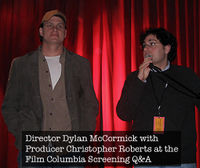IndependentFilm.com
http://www.independentfilm.com/films/1-dylan-mccormick-four-lane-highway.shtmlDylan McCormick - “Four Lane Highway”
McCormick Modernizes the Cinematic American Road Trip
McCormick Modernizes the Cinematic American Road Trip
[an error occurred while processing this directive]
Edit page New page Hide edit links
Merging stunning scenery and complex character study, McCormick’s “Four Lane Highway” offers audiences quite a ride. The film’s opening shots center on the handsome character of Sean, a late-twenties construction worker awaking after a night out on the town. Stuck in a hazy existence of partying, bed hopping, and deadening jobs, Sean’s maturity appears stunted by the mythic image of his father, a one-hit literary wonder whose novel gives the film its title, and the memory of his former artist-lover, Molly. Suddenly, Sean’s groggy morning routine comes into sharp focus while making his walk of shame across the local college campus. After a one-night stand with an undergrad, Sean spies a flyer announcing Molly’s forthcoming gallery opening on a message board. Although two years have passed since Sean last saw Molly, the flyer’s invitation propels Sean’s desire to leave his small town in search of his lost love. This journey of self-discovery ends up taking him from the quaint Maine backstreets to the urban congestion of New York City’s boulevards and back again.
Inspired by 1970’s era “road” films, director/writer Dylan McCormick’s story puts a 21st century spin on the genre where man’s spontaneous desire to find the answers sends him out into the American landscape. Shot on super-16mm film, upstate New York native McCormick expertly substitutes idyllic Chatham, New York for the bucolic setting of Maine and uses Sean’s beat-up truck in place of “Easy Rider’s” Harley-Davidsons. McCormick relies on a sequence of flashbacks rather than roadside scenes to tell his story, yet this storytelling technique keeps the spirit of “Rider’s” personal odyssey alive. True to such journey films, McCormick realizes that the ride wouldn’t be as sweet without a companion, so he delightfully provides the character of Lyle, Sean’s faithful, funny, and flushed sidekick.
While Sean’s analysis of his relationships is the intended focus of the film, actor Reg Roger’s portrayal of Lyle steals the show. While the lovers, played with obvious range by theatre-star Fred Weller and McCormick’s indie-actress wife, Greer Goodman, drive the conflict, Roger provides some terrific moments of comic relief. McCormick’s sensitive characterization of Lyle and Roger’s inspired acting are the highlights of this film.
Lyle, the bleary-eyed, unemployed barstool philosopher, is initially skeptical of Sean’s trip to reclaim his lost love, but nevertheless joins him. McCormick’s dialogue shines when Lyle enters the scene. When he wakes from his drunken stupor to find friend Sean packing for his sudden trip, Lyle tells him, “If you want to chase windmills, go to Holland.” As the film develops, McCormick solidifies his expert, unpitying depiction of this lovable, witty alcoholic. Upon arrival in New York City, Lyle flippantly says to Sean, who shakes his head in disapproval as Lyle pours liquor into his morning coffee, the shop “ran out of cream.” Roger’s acting adds a breath of fresh air to punctuate the tension and drama that hover in this tale of lost love and identity.
Ultimately, McCormick’s film poignantly paints those moments when our insecurities and frailties crescendo to the point where the very mortality of our existence and relationships hang in the balance. To first-time filmmaker McCormick’s credit his ending—however abrupt and predictable—is utterly satisfying. His closing sequence resurrects the belief in tilting at windmills, and reminds the audience that the significance to any journey doesn’t lie in the end destination itself. Rather it is found on the road along the way.
